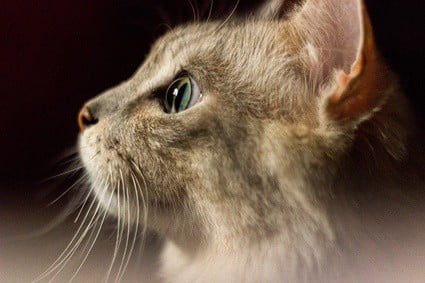Ear hair falls into two categories: ear tufts and ear hair furnishings. As a cat’s ear hair can look overgrown and messy, owners sometimes want to know if it’s safe to trim. However, only one type of ear hair can be safely trimmed.
You can trim the tips of the ear furnishings, but not the ear tufts. These prevent dirt and debris from entering the ear canal, assist with balance, and redirect sound. Cats’ ear hair should rarely be cut, but you can trim excess ear hair furnishings with blunt scissors.
It’s more important to keep your cat’s ears clean. In Science Direct, clinically normal cats in northern Greece had their ears studied for signs of a mite infestation. The rate of mite infestation was higher with the presence of ear discharge and acne-like lesions. Without proper care and attention, ears in poor health can lead to further problems.
Why Do Cats Have Long Ear Hair?
Ear tufts (lynx tips) are the fur that grows from the tips of the ears. Only certain breeds have ear tufts, such as the Main Coon, Norwegian and Siberian Forest cat, and Highlander.
Ear furnishings are the inner hairs that can be found inside the ears of cats. As mentioned, it’s important as it prevents debris from entering the ears and going down the ear canal.
According to NCBI, ear hair also filters sound. A cat’s ear hair covers the pinnae, which is essential for collecting sound and directing it into the external ear canal.
Should I Cut My Cat’s Ear Hair?
Trimming the ear tufts should be avoided as they’re vital for keeping dirt, mites, and insects out of the ears. Also, ear tufts showcase the special traits of certain feline breeds, distinguishing them from other cats.
Ear furnishings can be trimmed, but only at the very most tip. Safety is important because a cat’s ears are delicate, and a slip of the hand could result in injury. Groomers don’t usually cut the hairs inside or protruding from the ear as they’re too important for a cat’s overall well-being.
A cat’s ear canal features a self-cleaning mechanism. However, the ears are sensitive and can develop irritant reactions. Therefore, ear hair should only be trimmed if it’s causing severe irritation or has become infested with mites.
How to Get Cat Hair Out of Ears?
Before you start tidying up your cat’s ear hairs, perform a gentle clean. Then, have a look inside to see if there are any obvious issues. This includes dirt lodged in the ears, excessive wax, sores, discharge, redness, or inflammation.
Check for the presence of mites. They look like small, black dots. Where mites are present, you’ll also discover a smelly reddish-brown discharge. In addition, mites are itchy, so cats will scratch their ears excessively if they have an ear mite infestation, thus alerting you to the fact that something’s wrong.
If the ears are free from mites, you can proceed. If mites are a problem, your cat should be seen by a vet. You can give your cat’s ear hair a trim yourself. Don’t cut too much hair off your cat’s ears – only the tiniest amount is required.
Tools Needed
- Blunt scissors
- Small flea comb
- Cotton wool balls
- Alcohol-free ear cleaner

Step-by-Step Guide
- Comb through the ear hair with a flea comb to break up any wax or debris.
- Dampen a cotton ball with an alcohol-free ear cleaner. Wipe the hair gently until the debris comes off onto the cotton ball. Do not use cotton swabs as they can push wax or debris further into the ear canal.
- Take the blunt scissors and trim the parts of your hair that need to come off.
Don’t use an ear cleaner that contains tea tree oil, essential oils, or benzoyl peroxide, as these are toxic to cats.
There’s usually no real need to cut off a cat’s ear hair. While many owners may deem it as unsightly or too long, it’s usually a cosmetic issue. In addition, cutting off too much ear hair could lead to other problems.
Does Cat Ear Hair Grow Back?
A cat’s ear hair will eventually grow back if cut. The rate of growth will vary depending on your cat’s breed, age, and lifestyle. Given time, the hair will return to its original length, perhaps longer.
Ear hair can sometimes fall out as your cat grows older. Many Persian cats begin life with very long ear hair that looks too long relative to the size of their head. As they grow older and their heads and ears get slightly larger, the ear hair becomes proportionate to their size.
However, various factors may cause a cat’s ear hair not to grow back at all. This is usually the case if you cut off too much or there are underlying issues not treated before trimming the ear hair.
Ear Mites
Known as Otodectes cynotis, ear mites cause severe itching. This will cause your cat to scratch its ears, likely resulting in hair loss. In addition, ear mites can be transferred from cat to cat, so they need to be treated without delay.
Mite infestations can also cause mange. This is where the skin becomes covered in a grayish-yellow crust that is itchy. Mange will almost always lead to hair loss and is an unpleasant condition for your cat to bear.
Ear hair is essential in protecting the ear canal from parasites. Therefore, cats with fewer hairs inside their ears will be more susceptible to an infestation.
Fleas
The saliva from a flea bite can cause a reaction that makes your cat itch. So, if a flea has bitten your cat around its ears or head, it may rub against surfaces or try to scratch its ears for some light relief. Ear hair is particularly vulnerable to loss when your cat reacts this way to the discomfort.
Ringworm
Ringworm is a fungal infection that lives in the hair follicles, feeding on a cat’s dead skin cells. It’s highly contagious, and you’ll often find crusty patches around the ears, or anywhere else it has infected.

Allergies
Allergies can cause hair loss, intense itching, and oozing sores around the ears. Cats with allergies may lose hair around their ears first, as this is usually the first place your cat will start to scratch. Therefore, finding the cause of the allergy is important. So, food trials and other tests will be needed to discover the reason for the allergy.
Stress
Some cats don’t enjoy being groomed. In fact, it can cause stress in cats that dislike the sound of the tools being too close to their ears. This can even, in rare cases, lead to a lack of hair growth once the ear hair has been trimmed.
Stressed cats will cry out, kick, run away, hide, and do anything to get away from the grooming table. If your cat appears anxious and agitated when it undergoes grooming, leave your cat’s ear hair as it is.
If you’re cutting your cat’s hair for aesthetic reasons, your cat won’t appreciate any of the benefits. So, instead, focus on keeping your cat’s ears clean and debris-free while checking for mite and flea infestations.

